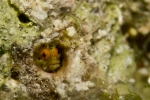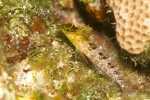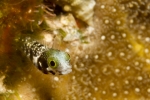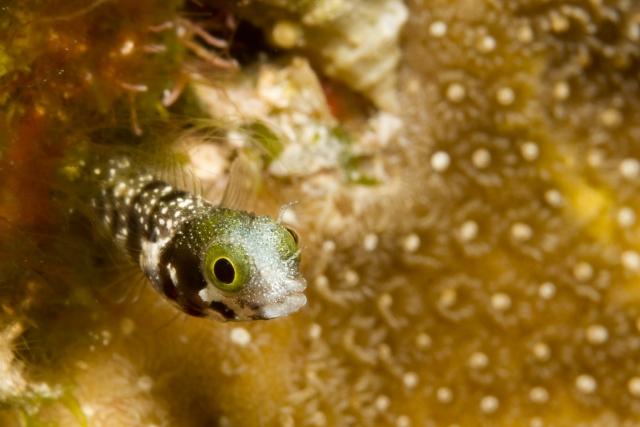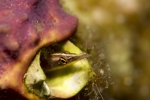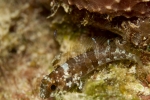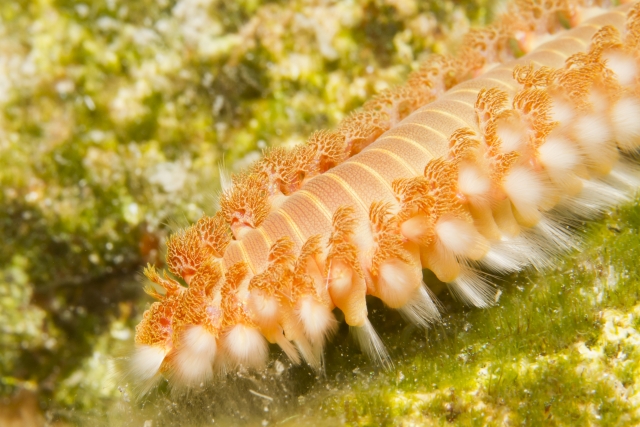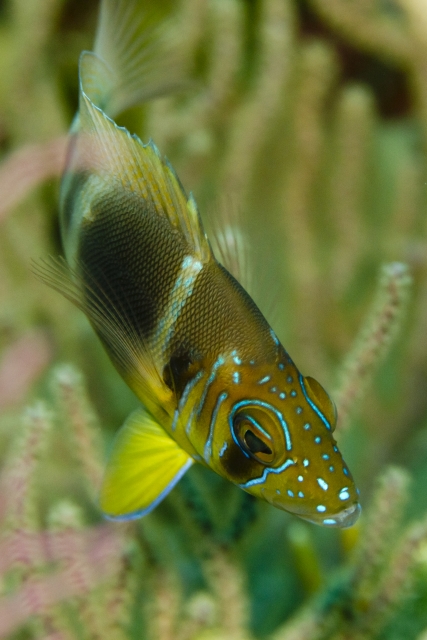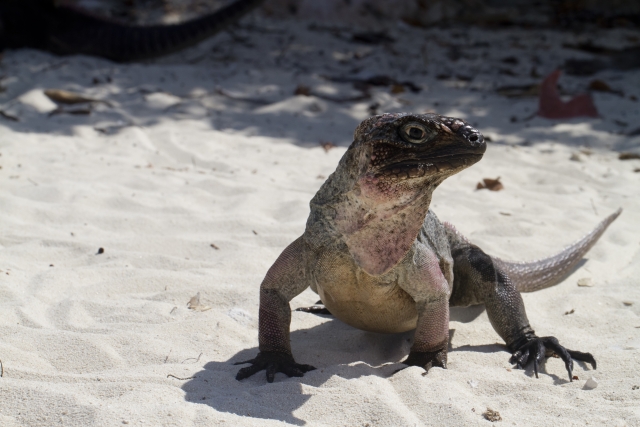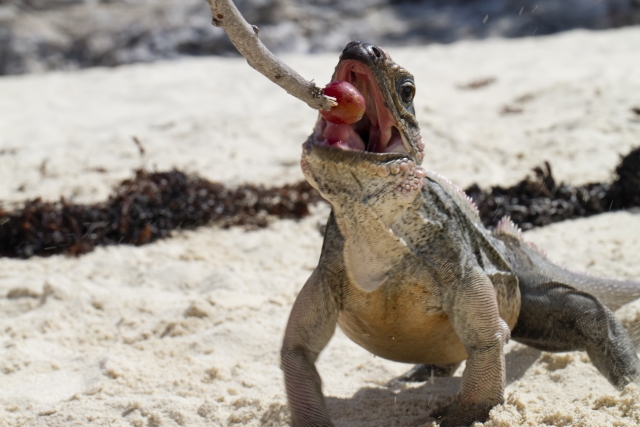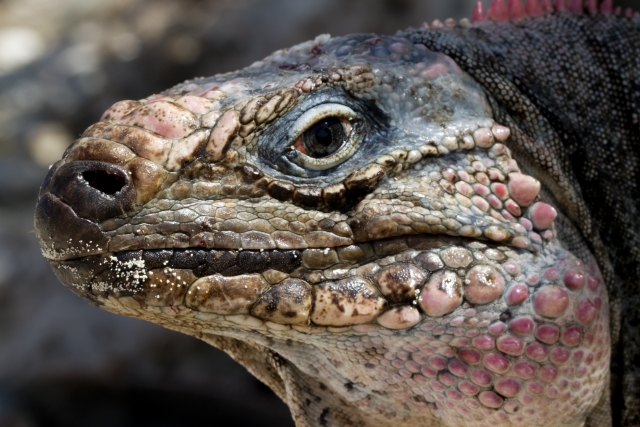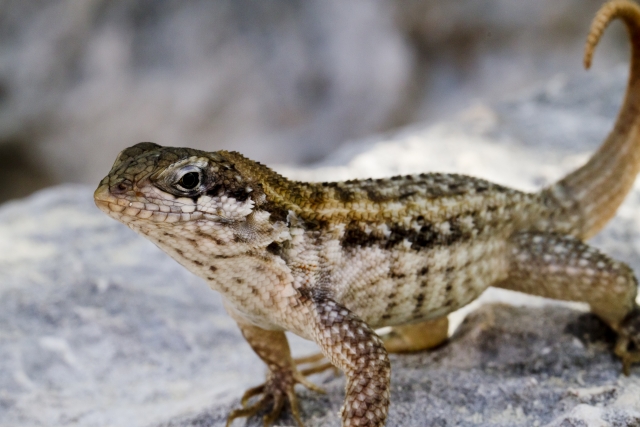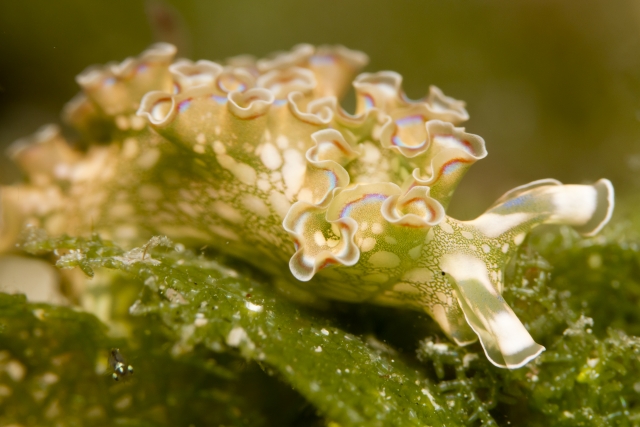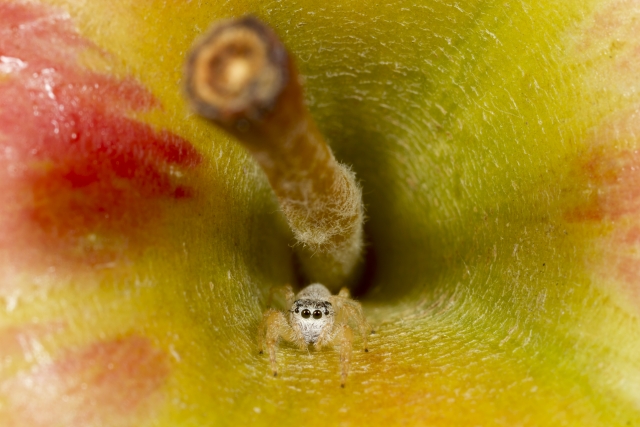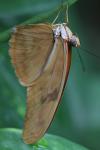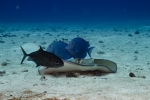macro
Aqua Cat: Batch of Blennies
ktuli — Mon, 12/29/2014 - 20:45
Blennies are small reef fish that can often go unnoticed due to their often shy nature and cryptic camouflage. Here's a nice set of blenny portraits...
I've shared other posts with blennies in the past, and it seems that they are a favored photo subject for me.
A fun story with the pikeblenny... Anya found this little guy during our shark feeding dive on our last trip. While the rest of us were completely engrossed in the twenty-or-so sharks ranging in size up to about eight feet long, Anya was interacting with this little fellow on the sandy ocean floor. I managed to get a few shots with the wide-angle lens, but focusing was a bit of a challenge. If you look closely, that feisty little guy is coming up out of its hole to bite Anya's finger. It also took a few nips at me as well - so we can say with complete honesty that we've sustained multiple bites during a shark feed dive!
- Bill
Aqua Cat: Bearded Fireworm
ktuli — Mon, 12/22/2014 - 19:10
Ok - I've been lazy/busy (take your pick) and haven't been posting often, but here's a cool shot of a Bearded Fireworm (Hermodice carunculata) taken on our recent dive trip. We didn't see too many of these until the last day or so of diving, then they seemed to be everywhere. This one in particular really appears to be on fire and definitely illustrates one of the sources of its name - the other is from the fact that those white bristles you see can inject a painful toxin that causes a burning sensation. Definitely not something you should mess with!
Technical Data: Canon EOS 7D, Canon EF 100mm f/2.8L Macro IS USM, 1/250th sec at f/16. Image Stabilization on. ISO 400. Ikelite Housing and Port and Ikelite 161 Strobe in TTL Mode. Raw conversion and cropped in Photoshop CS5.
Thanks for stopping by.
- Bill
Aqua Cat: Bloodworms are Photobombing Jerks!
ktuli — Tue, 12/09/2014 - 10:10
So we've talked about feeding bloodworms to reef critters on multiple occasions, and I've briefly touched on how annoying they can be... but today I will show just what photobombing jerks they really are...
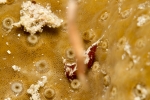 |
 |
 |
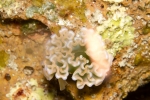 |
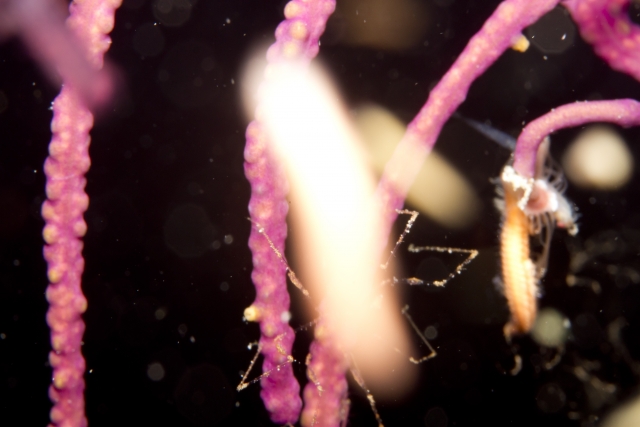 |
|||
The night dives in the Bahamas were especially bad with bloodworms, and this is just a small sampling of the photos ruined by these prolific little annoyances (most of the rest just got deleted).
- Bill
Aqua Cat: Caribbean Sea Spider
ktuli — Mon, 12/01/2014 - 21:07
Yep - you read that right - Caribbean Sea Spider (Andoplodactylus sp). I'm sure to some folks, it comes as no surprise that I managed to find spiders underwater too...
Ok - it isn't a true spider, but it is somewhat related. Both spiders and sea spiders are in the subphylum (the classification above class) Chelicerata. I've been fascinated with them ever since I first saw them listed in my identification, and so when I spotted one during a night dive, I instantly knew what I was seeing. I unfortunately did not come back with the best photos, but I'll explain that a bit more later.
 |
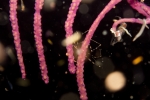 |
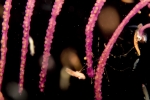 |
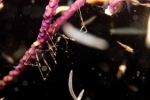 |
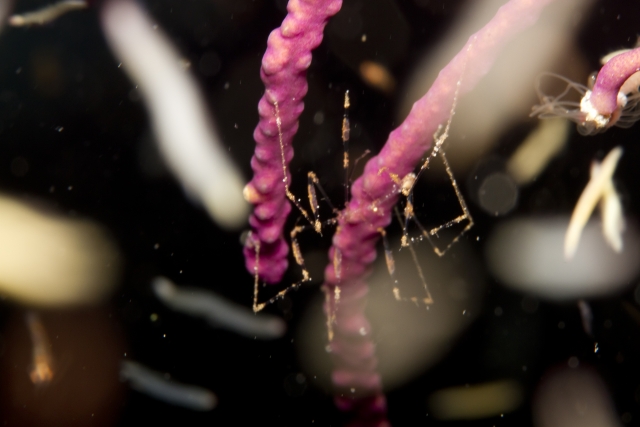 |
|||
Technical Data: Canon EOS 7D, Canon EF 100mm f/2.8L Macro IS USM, 1/250th sec at f/16. Image Stabilization on. ISO 400. Ikelite Housing and Port and Ikelite 161 Strobe in TTL Mode. Raw conversion in Photoshop CS5.
I know - I'm sure for most folks those photos look like a while lot of nothing - if you can even figure out what you're looking for at all. In general, the sea spider just looks like a jumble of legs to be honest, but like I said - I knew instantly what I was looking at and was thrilled with my find. I only spent about three minutes photographing it, and the conditions were absolutely horrible (I'll explain more on that tomorrow) and so I will have to continue searching for another one to get a decent photo.
But for now, I get to show everyone that there are spiders in the ocean too... :)
- Bill
Aqua Cat: Trapania dalva
ktuli — Mon, 11/17/2014 - 15:30
Ok - as promise, a new species of nudibranch to add to my list... Trapania dalva. There are pretty small nudibranchs only ranging in size up to about 10-12 mm (less than a half inch). Their white rhinophores and gills give them the appearance of detritus on the sponges that they tend to be found on.
 |
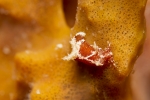 |
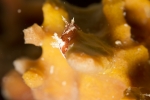 |
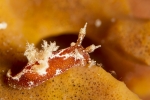 |
 |
|||
Technical Data: Canon EOS 7D, Canon EF 100mm f/2.8L Macro IS USM, 1/200th sec at f/8. Image Stabilization on. ISO 400. Ikelite Housing and Port and Ikelite 161 Strobe in TTL Mode. Raw conversion and cropped in Photoshop CS5.
Thanks for stopping by.
- Bill
Aqua Cat: Barred Hamlet
ktuli — Sun, 11/16/2014 - 18:35
A nice portrait of a Barred Hamlet (Hypoplectrus puella) today. This is another image that honestly at first glance I was about to toss. The positioning isn't as typical as you would think for a fish portrait and the depth of field and the positioning of the focus point ended up giving the photo a fairly soft look. Fortunately, after looking at it a bit, I decided that I really liked the different perspective (and honestly, it ends up doing a good job of drawing attention to those nice iridescent blue spots and lines on its face), and then I thought that perhaps that softer look gives this photo more of a feel of a painting as opposed to a photograph. I still wish I had framed this a little better (the edge of its tail is cropped off) and a tiny bit better focus and eye contact probably would have made it a bit stronger, but all in all, I am really starting to like this shot...
Technical Data: Canon EOS 7D, Canon EF 100mm f/2.8L Macro IS USM, 1/250th sec at f/6.3. Image Stabilization on. ISO 400. Ikelite Housing and Port and Ikelite 161 Strobe in TTL Mode. Raw conversion and cropped in Photoshop CS5.
More nudi photos tomorrow, so be sure to check back!!!
- Bill
Aqua Cat: Critter Assortment
ktuli — Fri, 11/14/2014 - 23:02
Ok - so time for another assortment, and admittedly it is mostly crabs, but I'm saving some nudibranch shots for the next post, so stay tuned...
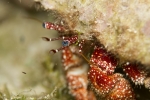 |
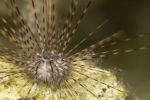 |
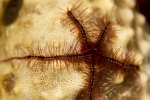 |
 |
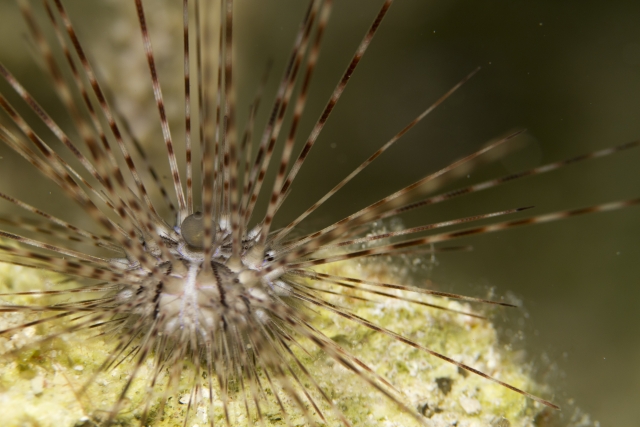 |
|||
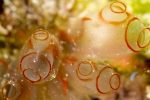 |
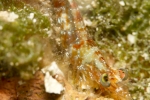 |
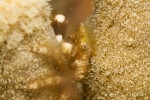 |
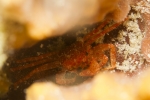 |
- Bill
Aqua Cat: Iguanas
ktuli — Thu, 11/13/2014 - 20:57
Ok - so admittedly not as cool as the swimming pigs, but we took a quick excursion between dives to go visit an island with a ton of iguanas...
Technical Data: Canon EOS 7D, Canon EF 100mm f/2.8L Macro IS USM, 1/320th sec at f/18. ISO 400. RAW processing in Adobe Camera Raw.
We fed them grapes - on a stick so they wouldn't be able to bite us! They really moved quick to get those grapes...
Technical Data: Canon EOS 7D, Canon EF 100mm f/2.8L Macro IS USM, 1/250th sec at f/18. ISO 400. RAW processing in Adobe Camera Raw.
Then they would settle down a bit and pose for some nice photos.
Technical Data: Canon EOS 7D, Canon EF 100mm f/2.8L Macro IS USM, 1/320th sec at f/18. ISO 400. RAW processing in Adobe Camera Raw.
And let us get pretty close...
Technical Data: Canon EOS 7D, Canon EF 100mm f/2.8L Macro IS USM, 1/120th sec at f/18. ISO 400. RAW processing in Adobe Camera Raw.
Then the smaller curly tailed lizards showed up (luckily we still had some grapes left and were able to sneak a couple past the iguanas to feed them too!
Technical Data: Canon EOS 7D, Canon EF 100mm f/2.8L Macro IS USM, 1/160th sec at f/18. ISO 400. RAW processing in Adobe Camera Raw.
Thanks for stopping by!
- Bill
Aqua Cat: Lettuce Sea Slug
ktuli — Wed, 11/12/2014 - 20:14
Ok - going to jump ahead because Anya requested I post this one for her...
The always beautiful Lettuce Sea Slug (Elysia crispata).
Technical Data: Canon EOS 7D, Canon EF 100mm f/2.8L Macro IS USM, 1/200th sec at f/8. Image Stabilization on. ISO 400. Ikelite Housing and Port and Ikelite 161 Strobe in TTL Mode. Raw conversion in Photoshop CS5.
I should point out that that tiny black dot under its rhinophore is its eye... now you know, and knowing is half the battle! :)
Though - to be honest, we saw many more (and more beautiful) lettuce sea slugs on our Caribbean Explorer trip (check those posts out here).
- Bill
Jumping Spider on my Apple
ktuli — Tue, 11/11/2014 - 19:24
A quick break from the dive trip photos today to share a spider shot.
So I have this obsessive-compulsive behavior when I eat an apple - the first thing I do is to remove the stem. I don't know why, I just do. Anyway, I went to eat an apple I had packed in my lunch, and I noticed a web in the spot where the stem comes out. So I gently remove the stem, and low and behold, there is a small jumping spider that had been living in the web.
Somehow he had survived multiple days in the refrigerator living on that apple, and as a coworker pointed out... of all the millions of apples in the world, that spider managed to pick the right one to decide to hang out on. Not only did he not get squished (which I am sure would have been the reaction most people would have had), he got save in a container, taken home, given his own photo-shoot, and then released into a house plant to be able to stay warm and hopefully survive the winter.
Technical Data: Canon EOS 7D, Canon MP-E 65mm f/2.8 1-5x Macro, 1/200 sec at f/16. Canon Macro Twin Lite MT-24EX in ETTL mode. ISO 100. RAW processing in Adobe Camera Raw.
Hopefully that doesn't put anyone off from eating apples - out of the hundreds and hundreds of apples I've eaten in my lifetime, this really is the first time I've ever had a spider on one. And yes, this photo is staged... since I wanted to finish my lunch and I had kind of destroyed the web already by removing the stem, I had to put the spider on a different apple once I got home.
- Bill

